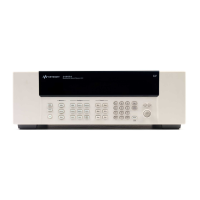268 34980A User’s Guide
10 64-Bit Digital I/O Module with Memory and Counter
To read digital data with more control over the channel parameters,
use the SCPI CONFigure and SENSe commands. The CONFigure commands
set up the digital I/O channel parameters. For example, sending the
following SCPI command to a Digital I/O module installed in slot 1 of the
mainframe, sets a 16- bit input channel (103) to use a 2.5 V input
threshold, and normal polarity.
CONF:DIG WORD, 2.5, NORM, (@1103)
Once configured, the data is read using the following command.
SENS:DIG:DATA:WORD? (@1103)
You may also read an individual bit using the SENSe commands.
This allows you to check the state of an individual bit in a channel
without having to create an input mask. For example, the following
command returns the state of bit 3 in the channel 101 byte.
SENS:DIG:DATA:BIT? 3, (@1101)
The acceptable range for the bit parameter is based on the channel width
as shown below:
• BYTE (8- bit): <bit> can range from ‘0’ to ‘7’
• WORD (16- bit): <bit> can range from ‘0’ to ‘15’
• LWORd (32- bit): <bit> can range from ‘0’ to ‘31’
The
SENSe command differs from the MEASure command in that it will not
change the direction (input or output) of the channel. If the channel is
configured as an output, the SENSe command will return the value being
driven.
Writing Digital Data
To write digital data, set the channel output parameters using the SOURce
commands. For example, sending the following SCPI commands to a Digital
I/O module in slot 1 sets a 32-bit channel to use normal polarity,
with active drive and a ‘set’ output voltage of 4 volts.
CONF:DIG:WIDT LWOR,(@1201)
CONF:DIG:POL NORM,(@1201)
SOUR:DIG:DRIV ACT,(@1201)
SOUR:DIG:LEV 4,(@1201)
The width and polarity parameters apply to both input and output
operations.

